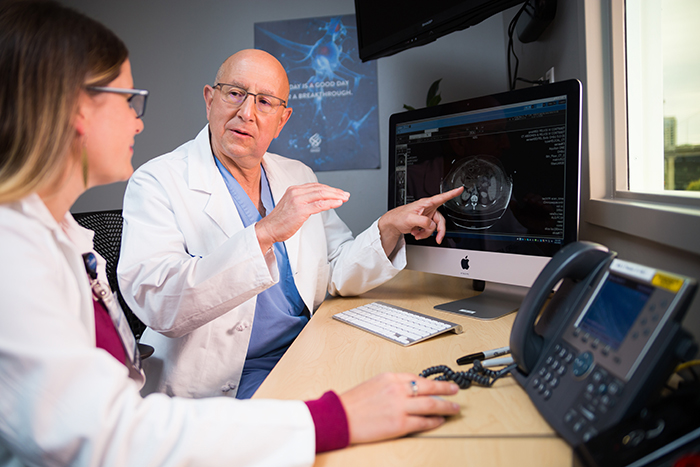Pancreatic Cancer Diagnosis

At the Knight Cancer Institute, you can be confident that testing for pancreatic cancer will be fast, accurate and compassionate.
You’ll find:
- Gastroenterologists (doctors who specialize in the digestive system) who do hundreds of tests a year
- Radiologists who do CT scans designed for pancreatic cancer
- Less-invasive biopsies (removing a tissue sample for testing)
- Pathologists with years of experience checking tissue for cancer
- Surgeons who can consult with your doctor right away about next steps
- A team that works together to give you the best care as soon as possible
This page is devoted to exocrine pancreatic cancer, which makes up about 95% of cases. We also treat pancreatic neuroendocrine tumors, or NETs.
Exam and medical history
You will have a physical exam. Your doctor will ask about your symptoms, medical history and family history to decide if you’re at greater risk of pancreatic cancer.
If your doctor suspects pancreatic cancer, you will have imaging and possibly other tests, such as a biopsy.
Pancreatic cancer imaging
CT scan
A CT scan uses an X-ray beam that circles the body to create detailed 3D images. Patients may be given a small amount of contrast dye by IV to better show any cancer on scans.
At the Knight, we take a special CT scan of the pancreas. Our doctors have spent years making sure these scans are as accurate as possible. We often find important information on our scans.
MRI scan
Your doctor may follow a CT scan with MRI (magnetic resonance imaging). This scan creates more detailed pictures of your pancreas and nearby organs.
Endoscopic ultrasound
This test takes about an hour to an hour and a half. A doctor guides a thin, flexible tube with a camera, or endoscope, through the mouth down to the stomach and the top of the small intestine (duodenum). Patients are sedated.
An endoscopic ultrasound lets us see the pancreas, liver, blood vessels and lymph nodes without making any cuts. We can take a tissue sample through the tube. We check the stomach and small intestine for any problems that could be causing symptoms.
The endoscopic ultrasound and CT scan give doctors a detailed picture of any cancer and whether it has spread.
Our team offers the most experience and expertise with endoscopic ultrasounds in Oregon. Our interventional endoscopists (gastroenterologists with special training) do hundreds a year.
Abdominal ultrasound
If you have symptoms in your stomach, your doctor might start with an abdominal ultrasound. This test uses sound waves from a wand pressed against your belly to create images of the inside of your stomach.

Pancreatic cancer biopsies
In a biopsy, your care team removes a small tissue sample. A doctor called a pathologist uses a microscope to look for cancer cells and to see what type or types they are.
Biopsies include:
- Endoscopic biopsy: This is done during an endoscopic ultrasound.
- Surgical biopsy: This is done if doctors think your cancer has spread to other organs. They use laparoscopy, with small cuts in your belly, to get tissue.
- CT or ultrasound biopsy: This uses a CT scan or ultrasound to find the best place to take a tissue sample.
Pancreatic cancer blood tests
Blood tests check for:
- Bilirubin: A high level of this dark yellow-brown substance can mean a tumor is blocking the bile duct, which sits between the pancreas and liver.
- Tumor markers: Proteins can signal the presence of cancer.
- Blood sugar: High blood sugar is a symptom of diabetes, which can be caused by pancreatic cancer.
- Anemia: This happens when the blood has too few red blood cells or hemoglobin, a protein that carries oxygen through the body. Anemia is a common complication of pancreatic cancer.
- Electrolytes: These are minerals important for the body to work. Electrolyte disorders can be a side effect of pancreatic cancer.
Other imaging tests
- Abdominal ultrasound: If you come to your doctor with symptoms in your belly, your doctor might start with an abdominal ultrasound. This uses sound waves from a wand pressed against your belly to create images of your insides.
- MRI: This test uses powerful magnets and radio waves to create detailed images of inside your body.
Molecular profiling
Sometimes we can analyze your tumor at the molecular level. Generating a molecular profile of the tumor can give us clues to try new therapy that may be more effective.
While this area shows promise, however, it remains at the experimental stage.
Learn more
- Tests for Pancreatic Cancer, American Cancer Society
- Symptoms and Diagnosis, Pancreatic Cancer Action Network
For patients
Call 503-494-7999 to:
- Make an appointment
- Seek a second opinion
- Ask questions
Location
Knight Cancer Institute, South Waterfront
Center for Health & Healing, Building 2
3485 S. Bond Ave.
Portland, OR 97239
Free parking for patients and visitors
Refer a patient
- Refer your patient to OHSU.
- Call 503-494-4567 to seek provider-to-provider advice.
Cancer clinical trials
Clinical trials allow patients to try a new test or treatment.
Read more
Learn more about OHSU Knight Cancer Institute treatments:
- Surgery
- Chemotherapy/medical oncology
- Radiation therapy
- Immunotherapy
- CAR T-cell therapy
- Targeted therapy
Find other pancreas care at OHSU.